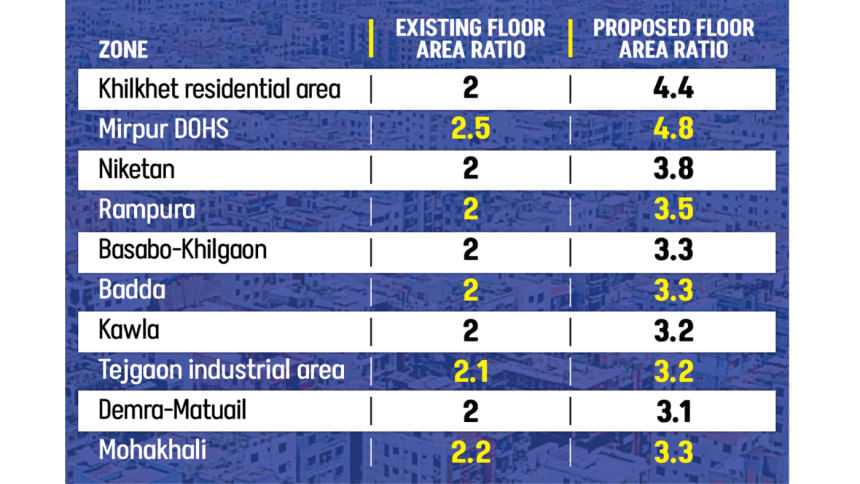Dhaka to grow upwards as builders have their way

Bowing to persistent demands from real estate developers, the government has decided to raise the limit on how much floor space can be built on a piece of land -- known as the Floor Area Ratio (FAR) -- in most parts of the capital.
This will spur a vertical expansion of Dhaka -- letting developers build upward with taller towers in an already overcrowded city.
Most of the capital's 68 zones have seen a rise in FAR ranging from 20 to 80 percent, according to a draft amendment to Dhaka's Detailed Area Plan (DAP) 2022.
FAR is the ratio of the total floor area of a building to the size of the land upon which it is built. For example, FAR of 2.0 means the total floor area is twice the size of the land.
A higher FAR means more people can live or work in a given area, which may lead to congestion and put pressure on infrastructure.
The draft shows that FAR has been raised to 4.4 from 2 in Khilkhet residential area; 4.8 from 2.5 in Mirpur DOHS; 3.3 from 2 in Badda; 3.1 from 2 in Faridabad; 3.5 from 2 in Rampura; 3.4 from 2.8 in Mirpur; and 3.3 from 2 in Basabo-Khilgaon area.
However, Gulshan-Banani and Dhanmondi, two of the city's upscale neighbourhoods, have seen a slight drop in their already very high FARs -- the former to 5.5 from 5.7, and the latter to 5 from 5.1.
The draft amendment was approved in principle at a stakeholders' meeting chaired by Housing and Public Works Adviser Adilur Rahman Khan at his ministry on August 10.
The approval has drawn mixed reactions from city planners, architects, environmentalists, and real estate developers.
Urban planners have warned that it could undermine the sustainability of Dhaka city, already overburdened with more than two crore residents in its 1,528-square-kilometer area.
An increase in FAR means a developer will be able to build a structure much taller than the one permitted by the existing rules, said Adil Mohammed Khan, president of Bangladesh Institute of Planners (BIP).
Giving an example, he said a developer is now allowed to construct a five-storey building on a five-katha plot in Khilkhet residential area. Once the new rules take effect, the developer will be able to build a nine-storey structure on the same plot.
"Dhaka's population density is already high. It frequently sees severe traffic congestion and is prone to waterlogging in the rainy season. A higher FAR will worsen these problems," said Adil, also a member of the technical committee that finalised the draft.
He pointed out that allowing the construction of additional floors will put utility services under strain and also reduce light and airflow into buildings.
The city planners initially opposed the idea of increasing FAR but eventually accepted it to break the deadlock with other stakeholders including real estate developers, he added.
Mohammad Fazle Reza Sumon, former president of BIP, said DAP 2022 was designed to curb indiscriminate and unplanned development that Dhaka city witnessed under the 2008 Building Construction Rules with much higher FAR.
"The vision of DAP 2022 was to prevent Purbachal from becoming another Uttara and ensure that Dhaka's new wards -- 42, 43, 44, and 45 -- don't turn into areas like Badda, Senpara Parbata and Mirbagh," said Sumon.
He mentioned that the revised FAR is somewhat better than what Real Estate & Housing Association of Bangladesh (REHAB), and Institute of Architects Bangladesh (IAB) had asked for.
The push to amend DAP began soon after a gazette on it was published on August 24, 2022, with developers and landowners opposing FAR restrictions.
At the end of last year, Rajdhani Unnayan Kartripakkha (Rajuk) began drafting an amendment following intensified lobbying and pressure from real estate developers.
On December 15, 2024, the government formed a seven-member advisory committee to oversee the process of making amendments to DAP under Rajuk's jurisdiction.
In March this year, the proposal was reviewed by an evaluation committee that included seven advisers to the interim government.
This correspondent called Adviser Adilur on his mobile phone several times and also sent a text message yesterday but he didn't respond.
Asked, Syeda Rizwana Hasan, adviser to the environment, forest and climate change ministry, said it was difficult for some stakeholders to accept DAP 2022, which marked a sudden 180-degree policy shift from the previous one.
"REHAB had objected to the FAR in the current DAP. Following a Rajuk initiative, an agreement on revised FAR was reached between various professional bodies at the last meeting," said Rizwana, also a member of the technical committee.
Welcoming the government move, REHAB has said an amendment to the DAP 2022 is long overdue.
"A strict restriction on FAR reduces available space for residential and commercial projects, making many of them financially unviable. This impedes our ability to meet growing housing demand," said REHAB Senior Vice-President Liakat Ali Bhuiyan.
"Though FAR has been increased, we are still not satisfied with some areas in the DAP," he said.
Md Ashraful Islam, chief town planner of Rajuk, said the draft will now be sent to the DAP Advisory Council Committee for final approval.
The provision for updating DAP every five years is a notable feature of the revised plan, Islam mentioned.
"To facilitate this, a technical committee will be formed within a year to help Rajuk upgrade and refine DAP," he added.

 For all latest news, follow The Daily Star's Google News channel.
For all latest news, follow The Daily Star's Google News channel. 



Comments